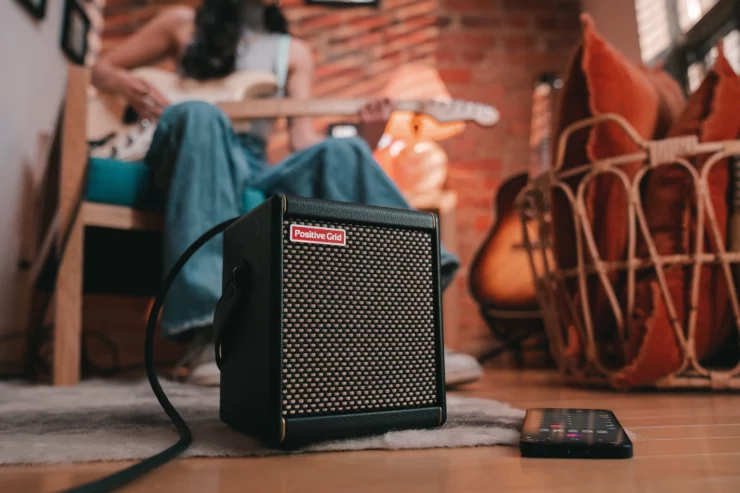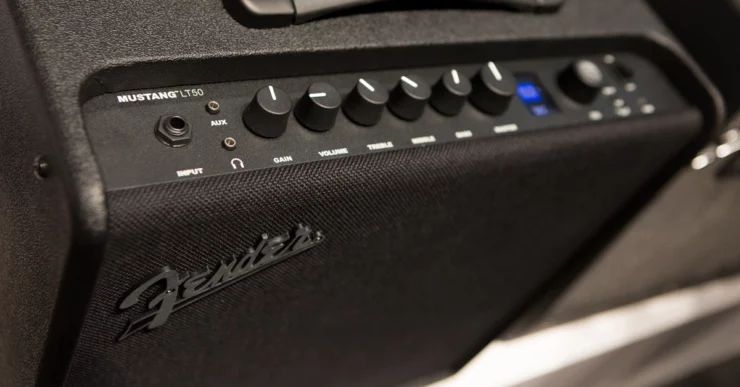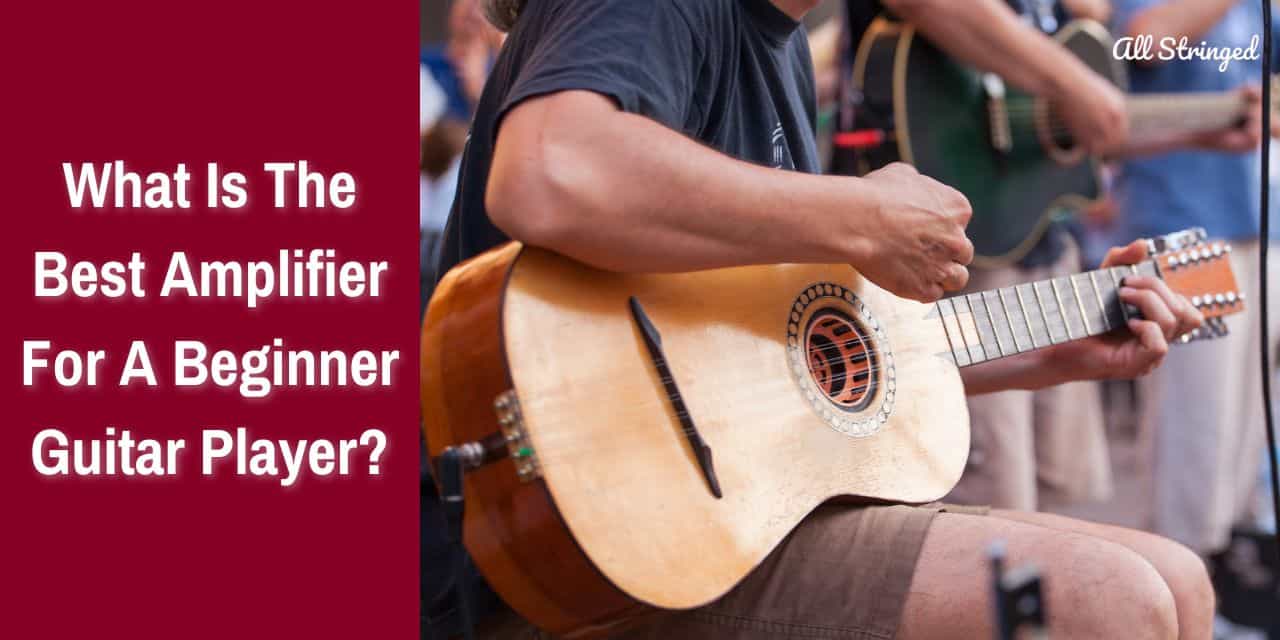Welcome, fellow guitar players! Are you looking for the perfect amplifier to start your guitar journey? It can be daunting to search for the right one with the many options out there. This article will give you the information you need to find the best amplifier for a beginner guitar player. Read on to learn more!
Factors to consider when buying a guitar amp for a beginner
Choosing the right guitar amp is an important decision for musicians and guitarists alike. The amp plays a key role in shaping the sound and delivering it with power and clarity. There are many factors that come into play when selecting an amp. Here are some of those factors to keep in mind to help you make a well-informed decision when choosing an amp.
#1. Power rating
The power rating of an amp determines its ability to deliver sound at different volumes and levels of distortion. The wattage rating indicates the power output, with higher wattages generally offering louder and more dynamic sound. Consider the environment in which you will be using the amp, such as home studios or small venues, to determine the appropriate power rating that suits your needs.
>>> Click here to read our review about the Top 15 Best Guitar Amps <<<
#2. Speaker size
The size of the speakers paired with the amp significantly influences the overall sound quality and protection. Larger speakers tend to provide deeper bass response and better low-frequency reproduction whereas smaller speakers excel at mid-range and high-frequency clarity. Consider the intended use and genre of music to choose an amp with the appropriate speaker size for your desired sound.
#3. Tone controls
Tone controls on an amp allow you to shape the sound according to your preferences. Typical tone control features include bass, mid-range, and treble adjustments. Some amps might also offer additional tone-shaping options like presence controls, contour switches, or graphic equalizers. Consider the flexibility and range of tone control options available on the guitar amp to match your desired sound signature.

#4. Effects
Many amps come equipped with built-in effects such as delay, reverb, chorus, or distortion. These effects can add depth, character, and versatility to your sound without the need for additional external pedals or processors. Consider the types and quality of effects offered by the amp and determine if they align with your musical style and preferences.
#5. Connectivity
The connectivity options of an amp are important for integrating it with other equipment and devices. Common connectivity features include input/output jacks, XLR or balanced connections, line outputs, headphone outputs, and effects loops. Make sure that the amp provides the necessary connections for your instruments, microphones, recording interfaces, or other audio equipment you plan to use in conjunction with the amp.
#6. Versatility
Consider the versatility of the amp in terms of the musical genres it can handle. Some amps are designed specifically for certain styles, such as rock, blues, jazz, or metal whereas others offer a broader range of tonal possibilities. A versatile amp allows you to explore different genres and adapt your sound to various musical situations.
Different types of guitar amps for beginners
Guitar amps play a vital role in shaping the sound and character of your guitar. They take the raw signal from the guitar and transform it into the powerful and expressive tones that define your playing style. With an impressive variety of guitar amp types available, it’ll be important to understand the differences and features they offer. Here are the different types of guitar amps available in the market and their unique characteristics.
#1. Tube amps
Tube amps are revered greatly for their warm, organic, and responsive tone. These amps make use of vacuum tubes to amplify the guitar signal, providing rich harmonics and natural compression. These amps are highly dynamic and sensitive to playing nuances, making them perfect for genres like rock, blues, and classic rock. They often produce a natural tube-driven breakup when pushed to higher volumes, delivering iconic overdrive tones.
#2. Solid-state amps
Solid-state amps make use of solid-state electronics, such as transistors or integrated circuits for amplifying the guitar signal. These amps offer a clean and precise sound reproduction with excellent reliability and durability.
These amps are popular among jazz, country, and clean-tone enthusiasts who prioritize accuracy, clarity, and consistent sound reproduction. Moreover, they are also more affordable and lightweight compared to tube amps.
#3. Digital modeling amps
Digital modeling amps incorporate digital technology for emulating the sounds of various amplifier types, effects, and speaker cabinets. These versatile guitar amps offer an impressive range of tones, allowing beginner guitarists to mimic the characteristics of classic amps, such as vintage tube amps or iconic British stacks.
Digital modeling amps often come with built-in effects, versatile tone-shaping options, and the ability to connect to a computer or a mobile device for deep editing and recording. They are often favored by guitarists who desire versatility and the ability to explore different sounds and styles.

#4. Hybrid amps
Hybrid amps combine the best of both tube and solid-state technologies. They typically use a tube preamp section for warmth and dynamics, paired with a solid-state power amp section for efficiency and reliability.
These amps offer a balance between tube-like tone and solid-state versatility. They can be a suitable option for various genres and are often favored by guitarists looking for a combination of vintage flavor and modern features.
#5. Acoustic amps
Acoustic amps are designed specifically for amplifying acoustic guitars and other acoustic instruments like violins or ukuleles. These amps feature dedicated EQ controls optimized for acoustic frequencies and often include additional features like mic inputs and feedback suppression. Acoustic amps aim to reproduce the natural, uncolored sound of acoustic instruments, ensuring clear and balanced amplification in live performance settings.
#6. Bass amps
Bass amps are designed for amplifying the lower frequencies produced by bass guitars. They typically feature larger speaker sizes and more robust power sections for handling low-end demands. These amps can come in different configurations, including solid-state, tube, or hybrid offering a range of tonal options suited to different musical styles, from funk and rock to metal and jazz.
What is the best amplifier for a beginner guitar player?
When you are learning to play the guitar, you would have probably dreamt of standing in front of an adoring crowd and delivering a performance that would have made even Freddie Mercury proud. However, as a beginner, you need to start small and work your way up. There is no better way to start than through a beginner guitar amp.
If you are new to the world of electric guitar, then getting your hands on a beginner guitar amp will mean you are prepared to take on your first riffs, chords, solos, and more, both at home when practicing alone or when jamming with friends. If you are going for a beginner model, you will probably get enough mileage out of it that can cater to the needs of seasoned veterans.
Thanks to the advancements in technology, you will not have to spend a lot of time when shopping for your first amp as a beginner guitar player. Here, you will get to know about some of the amps that answer your question of what is the best amplifier for a beginner guitar player. What’s even better is that these guitar amps are available at sensible price points.
#1. Boss Katana 50 MKII
Boss is one of the guitar industry’s best-known brands thanks to its incredible history in the world of effects pedals. The Boss Katana MKII has taken its rich heritage and translated it into one of the best value-for-money guitar modeling amps for beginners.
For a price point of slightly more than $200, you will get five different amp voicings. There are also 60 different effects, which means there is something in terms of tone for everyone. Add extra features like a USB PC interface such that you’re able to record onto your PC, which means you’ll get an overall compelling package.
With 50W of power and a 1×12 speaker, you will get a combo that can carry you along through the bedroom to the stage or in the rehearsal room.
#2. Fender Mustang LT50
As one of music’s most recognizable guitar brands, it is expected that Fender will have something for beginners. With the Fender Mustang LT50, you will not be disappointed. While this amp is classed as a single-channel amp, in reality, it packs in 20 different amp voicings for you to choose from, and a decent selection of good-quality effects.
You will find this amp’s preset ability to be quite useful. There are a lot of choices from different amps to different effect voicings. It will be nice to be handy to store the ones that you like for later use. This one is definitely a great addition to the list of best guitar amps for beginners.

#3. Blackstar Fly 3 Bluetooth
The Blackstar Fly 3 Bluetooth is the perfect amp for beginners who are short on space. Weighing in at slightly under 1 kg, this mini guitar amp delivers a surprising amount of volume through its three-inch speaker, whereas the two channels will ensure you can alternate between different sounds.
Meanwhile, the inclusion of the delay effect further rounds out the sound. You will definitely be a fan of the feature that allows you to connect two Fly 3 amps in stereo while being able to add Bluetooth inside to jam to backing tracks or music streaming will offer an extra element of usefulness.
It is definitely an amazing option for guitarists on the move, whatever your ability, and perfect for university students and anyone who has to keep the volume down.
#4. Blackstar HT-1R MKII
If the prospect of multiple amp voicings doesn’t appeal that much to you and you’re happy with one solid, high-quality sound that you can work with, the Blackstar HT-1R MKII might be the best beginner amp option for you.
It is essentially an all-tube amp, which means you get the glorious tones that the professionals rave about. However, it is a package small enough that can suit any beginner. Moreover, you won’t even have to turn it up too loud to get amazing sounds. What this amp lacks in features, it more than makes up for in terms of tone and ease of use. This is why it is one of the best amps for beginner guitarists.
#5. Vox VX15 GT
The Vox VX15 GT is slightly different from other amps on this list. As opposed to the standard construction typically found on a practice amp, this one has gone for an ultra-lightweight sealed cabinet made using ABS and has a bass-reflex design.
This unique design will give your tone the tight low-end that you are looking for while it ensures that all the sound is projected forward, where it is needed the most. This amp delivers an impressive range of sounds onboard, from vintage AC30 tones to killer high-gain metal sounds, meaning it has never been easier to find a tone that you love regardless of your playing style or inspiration.
#6. Fender Mustang LT40S
If you have somehow ended up in a box room or you have way too much stuff in your room, then the Fender Mustang LT40S is a great option. It will give you an impressive range of guitar sounds in an extremely compact form factor. You should not let the small size of the amp fool you as this guitar amp can pack a punch.
With the same guitar amp models as the regular range of options offered by Mustang, you’ll be able to dial in any tone that you can think of with this amazing amp. There are 30 presets, giving you an impressive base to start tweaking the tone. Moreover, there are 30 more custom slots once you have understand the art of sculpting sounds for your own creations.
Add in the impressive sounding effects, an intuitive LCD display, and an onboard tuner and you’ll get the perfect tool to practice at home. Thanks to its subtle appearance, it can fit in nicely with the décor. The headphone out and line in will give you everything that you need to get started on your guitar journey.
#7. IK Multimedia iRig Micro Amp
For smartphone or tablet users, the IK Multimedia iRig Micro Amp will be particularly interesting. This amp will connect to your device and through its Amplitude app, will allow you to access different amp voicings, effects, cabinets, and other tools.
The iRig Micro amp can either be powered by a power supply or by 6 AA batteries, which makes it both portable and versatile. This combination of features makes it one of the best beginner guitar amps. While it might not be one of the best combo amps ever, it still manages to tick all the boxes as a guitar amp for beginner guitar players.
#8. Line 6 Catalyst 60
The Line 6 Catalyst 60 comes from an impressive line that has released some of the best modeling amps ever created. Ideal for beginner guitarists, its combination of high-quality amp modeling and studio-grade effects has made the Line 6 Catalyst 60 an ideal option for beginners to start playing.
It has a nice even spread of amp models, taking you from clean sounds all the way to high gain madness. You will also find exciting boutique amp emulations and crunch settings ideal for the hard rock aficionado.
Line 6 is known for its high-quality digital effects, especially the reverbs and delays that shine through on this amp. You can use the Catalyst Edit app and be able to finely tweak the sounds. You can then save them to two memory slots for instant recall later. You can further add excellent recording functionality and you have a powerful amp that can do it all.
#9. Yamaha THR10II
Yamaha is responsible for releasing some of the best beginner guitar gear in the market. The company makes one of the best beginner guitars in the form of the Pacifica. To makes things even better, one of the best amps that you can get your hands on is the Yamaha THR10II amp.
This guitar amp offers an impressive range of tonal options in an extremely compact, stylish package that fits in any room. Straight out of the box, this amp will offer five incredibly realistic amp models and a wide array of studio-quality effects, and one bass guitar model as well as an acoustic guitar option. If all this wasn’t enough, there is also a mobile editor app, which will allow you to access even more sounds within the tips of your fingers.
#10. Orange Crush 20
While Fender and Marshall are better-known brands, many beginner guitarists gravitate toward Orange, a British amp giant, for their high-gain needs. The gain, distortion, and sound produced by the Orange Crush 20 are unlike any other.
The Crush 20 from Orange essentially takes the expertise and knowledge and manages to pack it all into a beginner-friendly solid-state amp. This 20W amp can serve any beginner metal guitarist perfectly. While it lacks effects of any kind, this is a small price you’ll have to pay for such an impressive tonally balanced amp.
How to test when choosing the right guitar amp
As a beginner guitarist, choosing the right guitar amp will be important in shaping your tone and overall playing experience. While recommendations and online reviews can offer valuable insights, nothing can match the peace of mind of testing the amp firsthand. Here are the different ways you can test your guitar amp and make a more informed decision to find a device that suits your musical style and preferences.
Listen to sound samples
One effective way of gauging the sound and tonal capabilities of a guitar amp will be by listening to sound samples. Many manufacturers and online retailers offer audio or video samples to showcase the amp’s sound characteristics. These samples demonstrate the different playing styles and settings, giving you a sense of the amp’s versatility. Pay close attention to the amp’s clean tones, overdriven sounds, and overall clarity and response to different playing techniques.
Moreover, explore online forums, YouTube channels, or music gear communities where fellow guitarists share their experiences with specific amp models. These resources can offer valuable insights and give you a better understanding of how the amp performs in real-world situations.
Test the amp in person
While sound samples offer a glimpse into the amp’s potential, nothing compares to trying the amp out in person. Visiting a music store or attending guitar gear expos will give you the opportunity to connect your guitar and experience the amp’s responsiveness, dynamics, and overall feel. There are certain steps to keep in mind like bringing your own guitar, testing at different levels, taking your time, and more.
Bringing your own guitar will ensure that you are testing the guitar amp with the instrument you are most familiar with. This will allow you to assess how the amp responds to your specific guitar’s pickups and tonal characteristics.
Explore the various knobs, switches, and controls on the amp to understand how they affect the sound. Adjust the gain, tone, and volume settings, to explore the amp’s range of tones and find the sweet spots that suit your playing style.
Play the amp at different volume levels for assessing its performance at both lower practice levels and higher volume settings. Pay close attention to any unwanted noise, distortion, or tonal changes that occur at higher volumes.
Experiment with different playing styles and genres that you typically enjoy. This will allow you to evaluate how well the amp handles clean tones, crunchy overdrives, or high-gain distortions depending on your musical preferences.
Spend sufficient time with the guitar amp to get a thorough understanding of its capabilities. Do not rush the testing process as it is essential to feel comfortable and confident in your choice.
FAQs
What type of amplifier should a beginner guitar player look for?
For a beginner guitar player, a practice amp is typically the best choice. Practice amps are designed to be lightweight, portable, and easy to use, making them ideal for home practice. They also typically have a lower wattage and have built-in features like headphone jacks and other controls that make them ideal for learning new guitar techniques.
What are the benefits of using a practice amp?
Practice amps are typically more affordable, lightweight and portable, and offer more control and versatility than regular amplifiers. They also usually have built-in features such as headphone jacks and other controls that make them ideal for learning new guitar techniques.
What should I consider when choosing a practice amp?
When choosing a practice amp, it is important to consider factors such as power and speaker size, available features, and budget. You should also consider how much space you have for storage and how portable you need the amp to be. It is also important to find an amp that provides a great playing experience and meets your needs.




